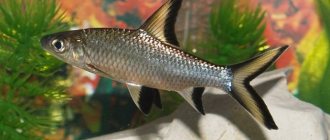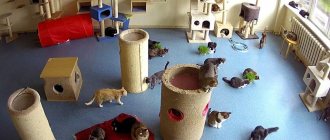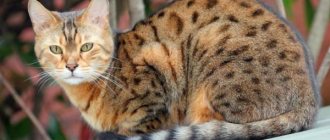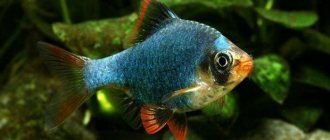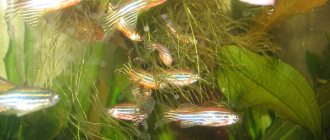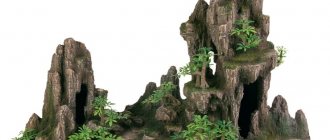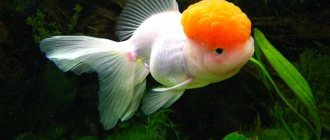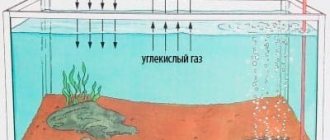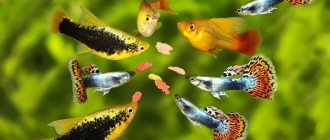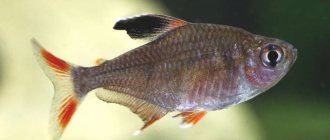Description of appearance, history of appearance, main types
Botia belong to the Loach family, representatives of which are not very popular among aquarists. Nevertheless, Botsia managed to attract attention due to its interesting features.
Botia live in the bottom layers of water, which directly affected their appearance.
Bots have a torpedo-shaped body and a high caudal fin. Near the mouth there are several pairs of sensitive antennae, through which the fish can dig up the soil in search of food. The pelvic and pectoral fins have suction cups, with the help of which Botsia attaches to stones or snags.
Botsia Dario
A distinctive feature of all Botsiyas is bone spines located in special sinuses under the eyes. As a rule, they are in a folded state, but in case of danger they suddenly stand upright. Despite the presence of such a formidable “weapon”, they are omnivorous fish, and plant foods occupy a large share of their diet.
Sexual differences are weakly expressed, and the size and color of the body depends on the type of Botius: among them there are gray, unattractive fish, and colorful, noticeable fish.
Botsy's homeland is tropical rivers of Southeast Asia. In 1852, a Dutch scientist discovered the species Botia macracantha, which subsequently became one of the most popular among aquarists.
Another name for these fish is Clown Botia, received for their unusual orange-black color and cheerful character (they are capable of clicking and clattering).
Botsia Clown
In 1855, the species of Botius Morlet became known. These fish are distinguished by a silver-gray body, along which an expressive black line stretches from the upper lip through the back to the tail.
Botia Morleta
A few years later, in 1865, biologists discovered a species of Botius Modestus, which has a gray-blue color, which becomes bright blue in dim lighting.
Botsia Modesta
1920 gave the aquarium world two more interesting species:
- Marble Botia, whose color resembles marble patterns;
- Bocia striata (Zebra), it received this name for its surprisingly bright color: many dark transverse stripes on a silver body.
Habitat in nature
In the wild, macracantha (another name) is found in rivers and streams in southeastern Asia. These fish are completely unpretentious to the cleanliness of the reservoirs in which they live; they can be found in crystal clear rivers and swampy streams. Under natural conditions, their diet consists of small insects, larvae and vegetation.
Consider the most popular types of fish: Maori wrasse, pipefish, labidochromis yellowfish, angelfish, red badis (Dario dario), arapaima, surgeonfish, arowana, ternetsia, parrotfish (red parrot), arapaima, gourami, barbs, discus and mollies.
Given the climate of Indonesia, the islands of Sumatra and Borneo, where these fish live, with the onset of the season of unfavorable weather conditions and during spawning, these fish leave their reservoirs and move to the flooded plains. It should be noted that these representatives of the aquatic world are not loners at all, but on the contrary, lead a gregarious lifestyle, gathering in small groups.
Important! Under natural conditions, fish reach a length of 30 or even 40 cm, and their life expectancy is approximately 20 years.
Requirements for an aquarium
Botia adhere to a benthic lifestyle, so the aquarist should provide a sufficiently large bottom area in the tank. Be sure to choose a wide and long aquarium, the height of which does not matter. It should be covered with a cover glass or lid, since the fish may jump out.
These fish react negatively to sudden changes in water parameters, so they should not be placed in a newly prepared aquarium. It is better if the container with other species, algae and other inhabitants sits for 2-3 months, and only then can Botsium be introduced into it.
Optimal water characteristics
Different types of Botia require different water parameters, but the general characteristics boil down to the following recommendations:
- temperature - from 24 to 27°C (some species like cool water - up to 22°C, others, on the contrary, require a warmer environment - up to 29-30°C);
- hardness - on average, 6-20°GH (the most popular species, Botia Clown, prefers soft water - 6-12°GH);
- acidity – 6.5-7.5 pH (for some Botia these values may deviate up or down).
In addition, the fish owner must monitor the level of nitrates and ammonia - ideally, these substances should not be contained in the aquarium. In any case, 25 to 30% of the total water volume should be changed every week.
Plants
Bots love to eat algae, but it is better to plant plants in the aquarium that perform another function: they protect these nocturnal fish from light. So, algae with wide leaves (nymphea, giant Vallisneria) or floating plants (riccia, pistia) are perfect. You can decorate the container with the help of hard ferns and mosses, which are not so attractive as food.
Priming
Botia are benthic species that spend a large amount of time at the bottom. In addition, they actively dig in the ground in search of food, and use their antennae for this. Often they even sleep right on the bottom, lying on one side, which frightens inexperienced aquarists. Therefore, you need to choose coarse homogeneous sand or small smooth pebbles as the soil.
It is important to consider that these fish create a strict hierarchy within the school, and weaker individuals sometimes require a variety of shelters to hide from the dominant Bots. In this regard, at the bottom you need to place a lot of snags, caves and other artificial shelters.
Equipment
Botia live in small rivers, so they require clean, oxygenated water and a moderate current. To create suitable conditions, it is necessary to use a filter, a compressor and additional pumps that will help create water movement.
Lighting nuances
Almost all species of Botia lead a twilight lifestyle, so bright lighting is not suitable for them. The fish will simply hide from the strong light, and their health will worsen.
Aquarium Basics
Botia is a rather unpretentious fish, for the successful keeping of which in a home artificial pond the following rules must be observed:
- Select a tank of such a size that it is sufficient to support a flock of 6-10 individuals. The volume depends on the variety; for dwarf species 150 liters is enough, for large ones 500-600 liters. The minimum group cannot consist of less than 5 copies of Botia. Otherwise, the fish will show aggression towards its neighbors.
- The tank should be equipped with a lid; these underwater inhabitants, despite the fact that they spend most of their lives in the bottom layer, are very active and playful and can jump out of the water.
- It is necessary to carefully select the soil, since the fish lie on it most of the time. These should be rounded fractions of sand or pebbles that are not capable of injuring the abdomen and sensitive antennae of pets.
- In order to reduce the level of conflicts in the Botia group, the tank must have a large bottom area, that is, it is better to choose a long and wide aquarium; height is not so important in this case.
- At the bottom, shelters from snags, grottoes, caves, stones, artificial decorative elements are needed, where the fish will sleep most of the day (except for those that do not lead a crepuscular lifestyle). The weaker members of the pack will always be able to hide from the dominant individuals.
- In natural conditions, Botia live in reservoirs with moderate currents and good oxygen saturation; it is necessary to create the same in the aquarium through filtration and aeration.
- Optimal parameters for the aquatic environment: temperature +20...+30 °C (depending on the type), high softness (hardness not higher than 10-12 °dGH, almost neutral acidity pH 6.0-7.5.
- Almost all species are twilight and nocturnal and do not like bright light, so it is worth using dim lighting in the aquarium or scattering it. This can be achieved by planting aquatic plants with wide leaves, for example, nymphea, giant vallisneria. You can also use those species that float on the surface - Riccia, Pistia. Shade-loving anubias, water moss, and ferns will also take root well.
- Botsium should not be introduced into a new aquarium; it should be at least 2-3 months old. This fish loves established hydrochemical parameters. Weekly water changes at a content of about 20%.
Kinds
There are more than 28 varieties in nature , which differ from each other, first of all, in color. These are not necessarily red and orange fish with white stripes. They are very different. A distinctive feature is their antennae, which they like to use to sort through the soil. Let's look at the most common types of fish:
Morleti botia morleti
Morleti are representatives of this fish that live in the Mekong River basin, Chao Phraya, Mae Klong in Thailand and Indochina. Loves warmer water with temperatures up to 30 ℃. They grow up to 10 cm.
Royal Botia Berdmorei
The royal fish is a small fish, 5-7 cm long, that lives in the bottom zone and likes to hide in thickets. The main diet is the remains of other food. There are transverse dark stripes on the body.
Dario Botia Dario
Dario is one of the most beautiful fish, which is also sometimes found on the territory of the Russian Federation. The main habitats are the Ganges and Brahmapurta river basins. Often found in Bhutan and Bangladesh.
Leconte Botia Lecontei
Leconte Botia Lecontei is a typical aquarium fish with grayish-green scales. It can grow up to 15 cm. The fish has long and very sharp spines for self-defense, which are exposed at the moment of danger.
Zebra Botia Striata
Striata is an inhabitant of rivers and streams in the western Ghats of India. They grow up to 9 cm, the optimal temperature range is 21-26 ℃, pH – 6-7.5. They lead a peaceful lifestyle, so they are great for aquariums. It has a dark body with transverse yellowish stripes.
Dwarf Botia Sidthimunk
The dwarf botia is another representative of the popular fish for aquariums. It requires the presence of individuals of the same size in the aquarium, because it leads a somewhat aggressive lifestyle. They grow up to 4 cm in length. For maintenance, 10 liters of water per individual is enough.
Blue botia modesta
Botia Modesta is a representative of tropical freshwater fauna in Thailand, Laos, Cambodia and Vietnam. The fish is gray in color, which gives way to grayish and greenish shades. Has yellow fins. Has up to 9 dark brown stripes.
Macracanta
Botia Macracantha is a common aquarium fish, native to Sumatra, Borneo and Indonesia. It grows up to 25 cm in an aquarium and has a three-color coloration. The body has wide black stripes.
Kubotai Botia Kubotai
Botia checkerboard is primarily found in the Salween River basin. The Kubotai borer its name due to its characteristic color with black and white flowers. They have a curved back and a straight abdomen. They have 4 pairs of antennae. In aquarium conditions they grow up to 13 cm in length.
Rostrata botia rostrata
Botia Rastrata or long-snouted, two-ribbon most often lives in Southeast Asia, India and Bangladesh. It is silver in color with double dark stripes. In an aquarium they grow up to 6 cm. It is recommended to keep up to 10 individuals in 150 liters of water.
Histrionica Botia Histrionica
Botia Histrionica is a fish up to 12 cm in length with thick black stripes on a white golden body. The main habitats are Burma, Thailand and Indy.
Almora botia almorhae botia lohachata
Botsia Lohataka or reticulated botia is a fish from the Loach family. Its main place of residence is Nepal, India, and Bangladesh. The body has the shape of a torpedo with a triangular cross-section. There are 3 pairs of antennae on the head. The silvery body is completely dotted with dark stripes. In an aquarium they grow up to 5-8 cm.
Emperor Botia Emperor
Botsia Emperor or Imperial is a beautiful aquarium fish with a yellow-black color. The tail is forked. The body length in captivity reaches 9 cm and can live up to 9 years.
Aquarist's Guide
Botia have a torpedo-shaped body, triangular in cross-section, with a flat belly and a sharp snout, surrounded by 6-8 antennae. They grow up to 30 cm in length in nature, up to 8 cm in an aquarium. Under their eyes they have infraorbital spines, hidden in the sinuses and barely noticeable. When in danger, the fish sharply protrude their spines with a loud click and fix them in a horizontal position. Using suckers on the pectoral and ventral fins, they attach to driftwood and stones, scraping algae from them and eating small young shoots of plants. Most bots are active at dusk.
Peaceful, schooling fish, they live in small groups, but they are aggressive when alone, so it is recommended to keep them in a group of 5-7 pieces. Botia are brightly colored, so they look great in aquariums.
According to various sources, bots include from 25 to 30 species of fish.
Types of botia
Clown botia (Botia macracantha, Chromobotia macracanthus) . In nature, the clown loachfish lives in reservoirs rich in aquatic vegetation in Southeast Asia and Indonesia (Sumatra and Borneo). It has been supplied to aquarists since 1936, and, as a rule, fish caught in the wild are sold.
Clown botia has an elongated, rounded body and magnificent coloring. The main body color varies from yellow to orange-red, with three transverse black wedge-shaped stripes. The dorsal fin is black and yellow only at the base; the caudal and ventral fins are colored black and red. The clown loach has large eyes without protective skin, under which there are sharp spines (the fish can tense and relax them). There are four pairs of whiskers around the mouth. At the slightest danger, the clown loach makes sounds resembling clicks. It can reach 30 cm in length. There are no external sexual differences in individuals.
It is necessary to keep the clown loach in an aquarium of at least 100 liters with dim light and numerous hiding places at the bottom. The soil required is soft, sandy. Plants in the aquarium are planted with large leaves that take root well in the soil. Clown botia can only live in a flock of 5-7 individuals; they die alone, so a species-specific aquarium is preferable. They grow very slowly and are not always hardy.
Water parameters for keeping: hardness 5 - 10°, pH 5.8 - 8.0, temperature 24 - 30°C. Filtration, aeration and weekly changes of up to 30% of the water volume are required.
Clown loaches are omnivores. They consume both live and dry food. It is advisable to give them plant nutrition and vitamins.
Bengal botia , or Botia dario . Other names: Cobitis, Botia geto, Diacanthus, Canthophrys flavicauda .
One of the most beautiful battles. In nature, it inhabits moderately fast small rivers of India in the state of Bengal, from which its name comes. They reach a size of 15 cm, in an aquarium - 8 cm. The body is moderately elongated and laterally compressed, with four pairs of antennae. Gold, with nine dark blue transverse stripes on a golden yellow background. Fish from different habitats have large differences in the width and number of stripes, and occasionally individuals with torn stripes are found. Other features of this species are spots on the caudal and pectoral fins, and faint black spots at the base of the anal and ventral fins. As they grow and mature, the color fades. There are no external sexual differences; adult females are larger and thicker.
The fish are great for a community aquarium. Peaceful and schooling fish. He likes the aquarium to be spacious (from 50 liters), with plenty of hiding places, dense vegetation and floating plants. The soil should be soft, sandy. These bots are visible all day, actively swimming throughout the aquarium in search of food, although in small form, and when they sense danger, they always hide. Fish love to explore bottom labyrinths, swarm in thickets of plants, and are reluctant to go out into brightly lit areas. They typically swim along the ground, tilted at an angle of about 30 degrees, in search of food. They love to sort things out in a group, constantly pushing or pinching each other. Some fish may lie down on a stone and jealously guard it, and other darios will definitely try to reclaim this place. The larger the flock, the more interesting their behavior is.
Like other botias, Bengal botias grow unevenly. Out of five or six fry, after a couple of months, two fish will definitely be larger, and one or two will be smaller than their counterparts. They get along easily with other fighters. But snails do not get along with dario, as they are their delicacy. For feeding, use flake food, granules, frozen bloodworms or brine shrimp, as well as cucumber slices. In an aquarium with this type of bot, active filtration and regular water changes are necessary. They react acutely to water and soil pollution, against which bacterial infections and ulcerative processes occur. Successful treatment with antibiotics is possible only in the early stages of the disease. Thanks to intestinal respiration, they easily tolerate unfavorable oxygen conditions.
Water parameters for keeping: Temperature (t) 23-26°C, acidity (pH) 6-7, hardness (dH) 5-10°.
Checkerboard botia (Botia kubotai) . Homeland - Burma. This beautiful fish, one of the new representatives of its genus, was described only in 2004.
The chess fighting game has an elongated body. The back line is arched, the abdomen is almost straight. The head has a blunt shape and is equipped with four pairs of antennae. The eyes are large. The tail fin is two-lobed. The main background of the body is inky with rows of alternating large and small light spots. All fins are light with blue-black stripes. Gender differences: not identified. The chess botia grows up to 10 cm in length.
The chess botia is a very active, peaceful and slightly shy fish. It must be kept in a group of 6-8 individuals with active, but not aggressive fish species that will not bother the fish with their excessive attention. Shows activity during the day. You can often watch how a cheerful flock of bots scurry around the aquarium in search of food, chase each other, or how a pair of young fish sort things out (at the same time, their color becomes much paler). The chess bot is not a territorial fish: up to 5-6 fish can peacefully coexist in one hollow snag. Bots love to rest on the wide leaves of plants.
To keep a chess bot, you need an 80-liter aquarium (for a couple of fish) with various shelters (snags, rock caves, flower pots) and thickets of plants planted near the side walls or in the background. Lighting should be dim and diffused. Sand or fine gravel is suitable as soil (bots like to rummage in the soil in search of leftover food).
Water parameters for keeping: hardness up to 15°, pH 6.8 - 7.5, temperature 24-28°C. Constant filtration, aeration and weekly changes of up to 30% of the water volume are required.
The chess fighting dog is susceptible to skin parasites. For food, the chess botia consumes live food (bloodworms, coretra, loves snails) with the addition of vegetables (lettuce, spinach, etc.) and substitutes. It is necessary to periodically arrange fasting days, as the fish are prone to overeating.
Burmese botia, or Botia histrionica . Other names: Assam botia, Burmese loach. Homeland: India, Myanmar, Thailand.
This type of botia grows up to 11 cm in length. It has 5 wide black stripes on the body, which disappear on the belly with age. A thin line crosses the eye. The tail blades have 2 stripes. The coloring of fish at a young age is different from that of an adult. The fry are striped. And only by three to four months do they acquire their adult coloration. It is believed that the main difference in the color of the Burmese botia is the vertical stripes in the form of the Latin letter “Y”.
When young, Botia histrionica, Botia kubotai, Botia almorhae and Botia rostrata are almost identical and are often confused, but in adult form they differ in stripes, color and size.
Burmese bots are a relatively calm species. Schooling and curious fish. It is best to keep these bots in a group of 5-6 individuals with a predominance of females. Tireless swimmers, incl. and in the central part of the aquarium, preferring lower water levels. Unlike other bots, they can be seen regularly during the daytime if there is enough cover and clean water. During the day they happily swim throughout the aquarium in search of food. At night they sleep in shelters. Young fish often sort things out, and the body becomes much lighter and the pattern almost disappears. But you shouldn’t be afraid, because... in a fight they do not cause damage to each other. They get along well with neighbors of similar sizes in a semi-shaded aquarium decorated with driftwood and aquatic plants.
It is necessary to equip the aquarium with many shelters from grottoes, driftwood, and plants. Lack of space provokes civil strife both within the group and in relation to neighbors of other species. Lighting should be soft and diffused. The soil, as for all loaches, should be shallow and rounded, because the fish actively dig the substrate and can injure their lips. Good filtration and weekly water changes. Sensitive to sudden fluctuations in water parameters. They readily accept flake and granulated food, brine shrimp, bloodworms, and fresh vegetables. This fish will never go hungry, so avoid overfeeding. They eat snails. They can bite plants.
Water parameters for maintenance: pH 6.5-7.5; dH 6-10°; T 22-27°C.
Botia almorhae
or Botia lohachata Chaudhuri . Other names: Nosed Deya .
Botia lohakata under natural conditions lives in reservoirs of various types in Pakistan, India, Nepal and Bangladesh. This fish has been known to aquarists since 1912.
In its appearance, the Lohakata loachata is very similar to catfish, but it belongs to the order Cyprinidae. It has an elongated body: the back line is curved, the abdomen is almost straight. The body, like the fins, is painted silver with dark stripes forming a kind of mesh (hence the name mesh loach). The head of the lohakata loachata has a blunt shape and is equipped with three pairs of antennae. In nature, the length of the fish can reach 10 cm, in captivity it does not exceed 5-7 cm.
Botia lohakata is a peaceful, schooling and shy fish. Leads a bottom-dwelling lifestyle and likes to hide in various shelters. Botia lohakata is most active during the day.
It is necessary to keep the lohakata bot in an aquarium with a volume of at least 100 liters with dim light, numerous shelters at the bottom and an abundance of vegetation. The soil needs to be soft and sandy.
Water parameters for maintenance: water hardness up to 12°, pH 6.0 - 7.0, temperature 24 - 28 °C. Filtration, aeration and weekly changes of up to 30% of the water volume are required.
Botia lohakata is omnivorous. Eats live, frozen, dry and plant food. In an aquarium, the lojakata botia is very useful, as it feeds from the bottom, picking up what other fish have left. She is very gluttonous, especially in her youth; when she overeats, her belly becomes fat.
Breeding of the Lohakata borer has been mastered quite recently. An aquarium with a volume of 150 liters is required for reproduction.
Water parameters for propagation: water hardness 11°, pH 7.0, temperature 28°C.
A separator mesh is placed at the bottom of the spawning tank. At the beginning, the breeders are kept separately from each other and fed mainly with plant food. Dilution occurs using gonadotropic injections. During spawning, the males pick up the female under the abdomen with their pectoral fin and swim to the surface of the water, where the eggs are laid (this happens until all the eggs are swept). Immediately after this, the producers must be removed from the spawning ground (the parents do not show any care for the offspring). The fertility of Lohakata botia ranges from 3 to 5 thousand small grayish-green eggs. They swell to 2-2.5 mm and after 16-18 hours fry emerge from them. It is easy to take care of the fry; they even eat dry feed that is suitable for their size. At the age of 1 month, Lohakata botia reaches a length of 1-1.5 cm. Their color differs from the adult: at first the fry are striped, and as they grow older they develop a reticulated color.
Morleta botia or Ribbon botia (Botia morleti) . Other names: Botia horae . The homeland of the Morleta borer is Southeast Asia, Thailand.
Botia morleta has an elongated body: the back line is curved, the abdomen is almost straight. A distinctive feature of this fish is a narrow black stripe that runs from the tip of the mouth along the entire ridge of the back and ends in a wide black ring covering the caudal peduncle. The main background of the body is light brown; it allows fish to camouflage perfectly on the sandy bottom. On close examination, you can find small specks and streaks of brown color, sometimes with a yellow-orange tint, on the fins. Unlike other Botia species, the coloration of the Morlet botia remains unchanged throughout its life. The head has a blunt shape with large eyes without protective skin, under which there are sharp spines (the fish can tense and relax them). There are four pairs of whiskers around the mouth. It can reach 10 cm in length.
Botia morleta leads a bottom-dwelling lifestyle and likes to hide in various shelters. This is a schooling fish. There are extremely cocky and aggressive individuals (especially towards pantodons), so it is advisable to keep them in a species aquarium. Botia morleta becomes most active at dusk.
It is necessary to keep the Morlet bot in a 200 liter aquarium with dim light, numerous shelters on the bottom and an abundance of vegetation. The soil needs to be soft and sandy.
The water temperature should be 26 - 30 °C. Filtration, aeration and weekly changes of up to 30% of the water volume are required.
Botia morleta is omnivorous. Eats live, frozen, dry, plant food, loves to feast on snails.
Zebra botia or striped botia (Botia superciliaris, Botia striata) . The homeland of the zebra bot is South India, r. Tunga, Shivamagga. In natural conditions, fish are few and far between.
The zebra botia has been known to aquarists since 1920.
The zebra botia has an elongated body: the back line is curved, the abdomen is almost straight. It differs from other species in its intense and clear coloring. The main background of the body is silvery-yellow, and there are thin transverse stripes of a dark color expanding downward on it. The abdomen is yellowish-golden. The color of the fish depends on the place where it was caught and sometimes it is very similar to the Dario bot. The fins of the zebra loach are transparent with a slight yellowish tint and a pattern of black dots. The head has a blunt shape and is equipped with three pairs of antennae. In nature, the length of the fish can reach 12 cm, in captivity it does not exceed 5-7 cm.
Zebra botsia is a very peaceful, harmless, schooling fish. It is advisable to keep 4-6 individuals in the aquarium. Leads a bottom-dwelling lifestyle and is active throughout the day.
It is necessary to keep the zebra botia in an aquarium with a volume of at least 100 liters with dim light and numerous shelters at the bottom. The soil needs to be soft and sandy. Plants in the aquarium are planted with large leaves that take root well in the soil.
Water parameters for maintenance: water hardness up to 15°, pH 6.0 - 7.0, temperature 22 - 26 °C. Filtration, aeration and weekly changes of up to 30% of the water volume are required.
The zebra botia is unpretentious in food and consumes both live and dry food.
Net botia (Botia sidthimunki) . The homeland of the reticulated borer is Northern Thailand. Grows up to 5 cm in length.
For keeping, soft water with a temperature of 25-28 ° C, without nitrogen substances, rich in oxygen is recommended. It is better to keep fish in fairly densely planted aquariums with plenty of shelter, illuminated by subdued light. Soil is required (otherwise the fish will get sick), they prefer a soft sandy bottom. All these species from the genus Botia are bottom fish, where they most often look for food, which for them is insect larvae and worms. In captivity they eat both live and artificial food. They are sensitive to ectoparasitic ciliates (Ichthyopthirius mitltifiliis).
Botia lucas bahi . Homeland - Thailand. In an aquarium they reach a length of up to 8 cm.
They live mostly in streams. The body is elongated. Lower mouth, 3 pairs of antennae. The profile of the back is almost straight, the belly is curved. The back is gray-brown, the side is brown with a bluish tint, the belly is yellowish-white. On the side there are 10 - 15 unclear dark transverse stripes and numerous black dots. The fins are yellowish to reddish with rows of spots forming stripes. The fish are a little shy, peaceful, more or less territorial, but at times they stay in groups, sometimes there are skirmishes with each other, after which they separate into 2 or more schools, most often occupying the lower layer of water. During the day they stay in shelters and at night they explore the ground in search of food.
It can be kept in a general aquarium, which should have shelters and thickets of plants in places. Water 24 – 260C, dH 5 – 10, pH 6 – 7.5, water is oxygen-rich and clean, so the water must be aerated. There are small pebbles at the bottom. You need to feed them periodically with live and plant food, sometimes using substitutes.
Contents of the battle
The optimal aquarium for bots should be at least 60 liters. Botia are shy fish, especially when they are small, so it is necessary to create numerous shelters at the bottom - stone grottoes, driftwood, pot shards. The soil should be soft, sandy, because... Bots dig through the ground, looking for food, and can get injured if there are sharp pebbles at the bottom. The lighting is not very bright. Particular attention should be paid to water, because... Botia love clean water. Water changes should be done once a week, by 15-30%, and the aquarium itself should be provided with powerful filtration and aeration.
Water parameters, depending on the type, are as follows: water temperature - 22-300C, water hardness (dH) - 5-10°, acidity (pH) - 5.8 - 8.0.
Feeding the botia
Bots are very voracious fish, which is partly a problem for them, because with a constant feeling of hunger they can easily overeat, which can lead to death. Therefore, it is necessary to control the diet (no more than 1-2 times a day), which may consist of bloodworms, pieces of vegetables, flake and granular food, and brine shrimp. Bots also love to eat snails.
Breeding botia
Breeding bots in an aquarium is problematic. It is believed that in nature, adult fish migrate upstream of rivers, to their sources, where they spawn in the shallow coastal zone and adjacent swampy lakes. Later they return downstream.
For spawning, an aquarium of 250 liters is required. To stimulate spawning, the fish must be placed in conditions in which there will be fresher (clean), soft and acidic water with a pH of 5-6, as well as a temperature increased by 5-10 ° C. The incubation period is 18-48 hours (27-30°C). Productivity is about 150 eggs. To protect the eggs from their parents, a large amount of substrate is placed in the aquarium, and spawning sieves are placed on the bottom. Starter food - rotifers, dusted feed, etc. It is important that food is available around the clock in the first two weeks.
Compatibility of bots with other aquarium inhabitants.
buy Botsia in our aqua store .
Feeding
As already noted, Botsia eat any food, so their diet should be varied and balanced. They willingly feast on:
- larvae;
- bloodworm;
- dry flakes;
- frozen food.
It is especially important to take into account their need for plant food: for example, many aquarists give their fish cucumbers, zucchini, and melon.
If there is a lack of plant food, Botia will nibble on algae, but vegetables should also be given in moderation so that their remains do not pollute the water.
As a rule, they feed in the dark, so it is better to feed them in the evening, after turning off the lights in the room and aquarium. However, many species will forage at any time, so a strict feeding schedule must be maintained.
These fish can easily spend two or three days without food; some sources even advise periodically arranging fasting days, since Botsia have a tendency to become obese.
If there is a serious lack of food, they will try algae and also eat all the small snails, so you should not keep them hungry for too long.
Reproduction
Clown botia is very rarely bred in a home aquarium. There are only a few reports of spawning in a home aquarium, and even then, most of the eggs were not fertilized.
Individuals that go on sale are bred using gonadotropic drugs on farms in Southeast Asia.
It is very difficult to reproduce this in a home aquarium, apparently this is the reason for such rare cases of spawning.
Moreover, not everyone succeeds in breeding it in captivity; the most common practice is that the fry is caught in the wild and raised to adult size.
So it is quite possible that those fish that swim in your aquarium once lived in nature.
Breeding
Reproduction of the Clown Botia at home is difficult due to the intricate reproductive cycle, so previously only wild-caught individuals appeared on sale. This was reflected in the price. Later, in Southeast Asia, fish hatcheries began artificially breeding offspring using hormonal injections. But even this approach does not guarantee a successful spawning outcome.
The fish reach sexual maturity by growing up to 12-15 cm. Usually individuals no larger than 20 cm in size migrate to spawn, the rest remain in the river. This suggests that after reaching a certain age, Macracanthas stop reproducing.
During the entire period of observation of the pet in the aquarium, only one case of spawning in captivity was discovered. Quite by accident, while cleaning a tank, an amateur from Montreal saw about 40 Botsia fry under a bush of algae.
At that time, the water indicators in the tank corresponded to:
| Rigidity | Acidity | Temperature |
| 2° dH | 6.2 pH | +28…+29 °С |
What exactly happened at the time of spawning is unknown, since the pets hid in shelters and only swam out in the evening to eat. The aquarist fed the fish with ground beef heart and granulated food containing shrimp. The tank had powerful aeration and filtration systems.
Where does the clown loach live?
Photo: Botia clown in the water
The historical homeland of the fish is considered to be the territory of Southeast Asia.
Geographical regions of habitat of the macracanth fish:
- Indonesia;
- Sumatra;
- Borneo Islands;
In natural conditions they are inhabitants of rivers of various sizes. They lead a predominantly sedentary lifestyle. During the spawning period they usually migrate, but when it ends they return to their usual habitats. Fish can inhabit rivers both with standing water and where there is a current. During the monsoon period, they move to flat areas that are flooded by rivers. It can inhabit very clean water bodies, and at the same time those that are polluted.
Fish adapt quite quickly to new conditions, including in an aquarium. They do not require special, labor-intensive care. To create comfortable conditions, they will need a spacious aquarium, taking into account the fact that fish grow up to 20-35 centimeters. It is better to count on an aquarium for an average of 3-6 individuals, since the clown botia likes to live as part of a group.
The volume of water per individual is 80-100 liters. The main criterion is the absence of nitrates and additional impurities in the water. The presence of nitrates can lead to the death of brightly colored fish. One of the mandatory criteria is aeration and filtration, water temperature 25-28 degrees. It is best to cover the aquarium bottom with coarse sand or a minimum fraction of gravel, since the clown botia likes to move the bottom with its mustache.
There are also certain lighting requirements. It is best if it is diffused and somewhat muted. When choosing vegetation, it is better to choose species with tough foliage so that they cannot be eaten by them. These can be various types of aquatic ferns, cryptocorynes, echinodorus, and anibois. It is advisable to cover the aquarium with a lid so that its inhabitants cannot jump out of it. The swim bladder of the clown loach is divided into two parts by a kind of septum. The anterior part is enclosed in a bone capsule, the posterior part is practically absent.
Now you know everything about the contents and compatibility of the clown battle. Let's see what you need to feed the fish.
Compatibility with other fish
Since botsia is a schooling fish, problems with interspecific aggression usually do not arise. A school of fish is practically safe for any neighbors (except, perhaps, the dario botia). Here it is important to choose your neighbors so that they themselves feel comfortable next to these striped giants.
If the fish is left alone, and also quite old (over 6-7 years old), then it can show aggression towards its neighbors, especially new ones: building them, hunting for tails and fins, chasing them around the aquarium.
Considering that the botia itself is not averse to walking around the entire tank, it should have few neighbors: this way no one will disturb anyone. Overcrowding should be avoided. Otherwise, almost any non-aggressive and moderately aggressive fish that are comparable in size and do not have lush fins (golden ones) or growths (angelfish) will be suitable as neighbors. It is advisable to keep everyone in the same aquarium from an early age: it is more difficult for bots to accept beginners.
Compatibility
Bots cannot be called a fully aggressive fish. This is a gregarious inhabitant. If the correct hierarchy has formed in the group, then there will only be intraspecific acceptable conflicts, which constitute the way of life of these underwater inhabitants. In this case, the neighbors are unlikely to be interested in them.
The size of the flock is also important. In a small one, one weak individual is always chosen, and usually everyone else offends her. If there are at least eight copies in the family, then conflicts are distributed evenly, there is no pressure on one member.
The only Botia in the tank will feel uncomfortable and show aggression towards other inhabitants of the aquarium.
If there are other fish in the homemade artificial fish, then they should be as follows:
- angelfish;
- barbs;
- zebrafish;
- Corydoras catfish;
- gourami;
- guppy;
- mollies;
- platies;
- plecostomus;
- iris;
- rasboras;
- labeo;
- swordtails;
- tetras.
Fish with veil-like plumage are not recommended as neighbors; Botsia will nibble on it, as well as slow-moving species - cockerels, African and South American cichlids, discus fish, goldfish, Koi carp, shrimp and crabs, astronotus.
Diseases
In general, adult botia has good stable immunity. Infection with ichthyophthyriasis (semolina) and other fungal infections is possible. It is treated with the usual methods: increasing the water temperature, turning off the lights, adding special antifungal drugs. However, often, even if the entire aquarium is sick, the bots may remain unaffected by the infection. When treating an aquarium for infection, you should not remove healthy fish, so they can undergo preventive procedures.
Oxygen starvation
Pets lose their appetite and constantly rise to the surface of the water, gasping for air. The reason is overpopulation of the aquarium, lack of vegetation and lack of aeration. Treatment consists of eliminating provoking factors.
Chemical intoxication
Occurring due to the presence of chlorine or ammonia in water. The main symptoms are mucus on the gills, difficulty breathing, color change. Relocating your pets to a tank with clean water will help save them.
Stomach diseases
The main reason is poor quality food. Signs are the appearance of dark spots on the body, gradually turning into ulcers, enlargement of the abdomen, despite the lack of appetite, and the development of bulging eyes. The sick individual is removed and treated with streptocide or potassium permanganate.
To prevent infectious diseases, it is necessary to quarantine each new fish for a week before moving it into a community aquarium.
Diseases and prevention
All diseases that Bots owners encounter are most often caused by violation of the conditions of their maintenance. The most common pathologies are of the following nature:
- Gribkova. Usually this is gill and fin rot, the formation of a grayish mossy coating on the body of the fish. Methylene blue and Metronidazole are used for treatment.
- Parasitic. These include lesions by protozoa, the most common being ichthyophthyriasis (semolina). The fish itches on the ground, and whitish “cotton” lumps appear on the body. Malachite green and Formalin are used for treatment. Salt water and preparations containing copper and iron are prohibited. Botia are very sensitive to the composition of the aquatic environment.
- Bacterial. Typically, owners are faced with aeromonosis, vibriosis, corynobacteriosis, hemophilia, pseudomonosis, and tuberculosis. All of them are successfully treated with antibiotics in the early stages. But consultation with an experienced ichthyologist is necessary.
Another problem for Bots is obesity, which is caused by gluttony of fish. Here, only the owner can prevent pathology by limiting portions and preventing overeating.
How to choose the right one when buying and what to pay attention to?
When purchasing, you first need to pay attention to the appearance. Botia Clown has noticeable bright colors and clear colors. If the body looks faded, then the fish has obvious health problems. In addition, healthy Botsiyas are very active and vigorous, making them difficult to catch.
It is recommended to examine the aquarium in which the fish was kept. It should not show signs of neglect or poor care. It is very important for clowns to hide in shelters, so in a container without shelter their well-being and health will be undermined.
Finally, you should not buy too small (young) fish, even if it costs significantly less. The fact is that young Botia are extremely sensitive to the conditions of their detention, and moving to another aquarium will become a real stress for them. It is better to choose an individual that has reached at least 5 cm in length.
If you comply with all these conditions, and then carefully care for the Botsii, then the aquarist will be able to enjoy the colorful fish with unusual habits for a very long time.
Botsia and her entourage
Bots are often considered aggressive fish, although in fact this is not entirely true. Aggressive behavior is quite predictable on the part of lonely fish. They must live in flocks. Moreover, the greater it is, the less serious the manifestations of aggression. In small schools there is always one, weakest fish, which is bullied by everyone else. In large ones (more than eight individuals) there is not such a large concentration of attention on one individual.
The compatibility of bots with other types of aquarium fish depends on who you add to them. It should be remembered that battles are quite mobile creatures. They can cause discomfort with their behavior to calmer, slower fish. Under no circumstances should you add fish with veil fins to them . Representatives of cyprinids and loaches have a much greater chance of peaceful cohabitation. It is believed that these are ideal neighbors for them.
Table of compatibility of bots with other aquarium inhabitants.
The aquarium must contain all kinds of grottoes, driftwood, pots, and clay vessels. All bots like lighting that is more twilight and dim. By the way, the peak activity of these fish occurs in the evening. In the first half of the day, they prefer to take a nap somewhere under a snag. They sleep with their belly up, which often frightens inexperienced owners.
Botia love to pick at the remains of food at the bottom of the aquarium, this is one of the reasons why the substrate must be soft and safe. Often fish damage their skin on hard pebbles, which is very dangerous.
The water temperature in the aquarium should not be lower than 24 °C, but not higher than 30 °C. It is imperative to provide powerful filtration; the water must contain the maximum possible amount of oxygen. It is necessary to make it a rule to change half of the water to fresh water once a week.
Interesting Facts
Unusual pets differ not only in size, color and complex reproduction, but also in other features:
- The clicking or clattering sound that the fish makes frightens not only small neighbors in the aquarium, but also people unfamiliar with such pet abilities.
- Sometimes the fish shocks the breeder by falling asleep on its side or getting stuck in a crevice; from the outside it seems that the individual has died.
- Clown's abdomen has suction cups that allow it to attach to snags and rocks.
Sources
- https://aquariums.guru/obitateli/akvariumnye-rybki/vidy/botsiya/soderzhanie.html
- https://akvariumfish.ru/akvariumnye-rybki/rybka-botsiya
- https://MrHvost.com/bociya-kloun
- https://catfishes.ru/bociya-kloun-krasota-edyashhaya-ulitok-i-rasteniya/
- https://aquazhizn.ru/vidy-rybok/akvariumnye-rybki-bocii
- https://RybkiVBanke.ru/akvariumnye-rybki/botsiya-kloun
- https://aquariums.guru/obitateli/akvariumnye-rybki/vidy/botsiya/kloun.html
- https://aqua-south.ru/botsiya-kloun-s-kem-ih-mozhno-soderzhat-v-akvariume/
[collapse]
Description
This is a very beautiful, big fish. The body is elongated and laterally compressed. The mouth is directed downwards and has four pairs of whiskers.
Please note that the fish has spines that are located under the eyes and serve to protect against predatory fish. Botia exposes them at the moment of danger, which can be a problem when catching, as they cling to the net. It is better to use a plastic container.
It is reported that in nature they grow up to 40 cm, but in an aquarium they are smaller, about 20-25 cm. They are long-lived, under good conditions they can live up to 20 years.
The bright yellow-orange body color with three wide black stripes, active behavior and large size make the bots attractive for keeping in most aquariums.
One stripe goes through the eyes, the second just in front of the dorsal fin, and the third captures part of the dorsal fin and goes further behind it. All together, they form a very beautiful and eye-catching color.
It should be noted that the fish is most brightly colored at a young age, and as it grows older it turns pale, but does not lose its beauty.
